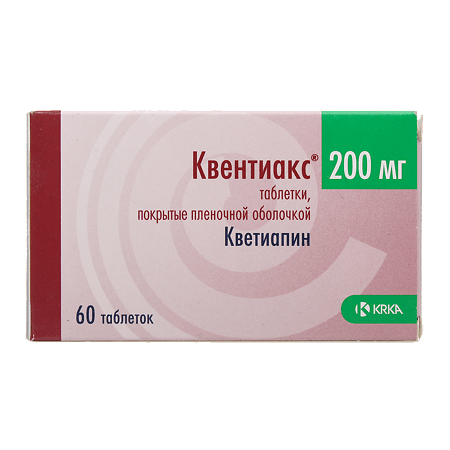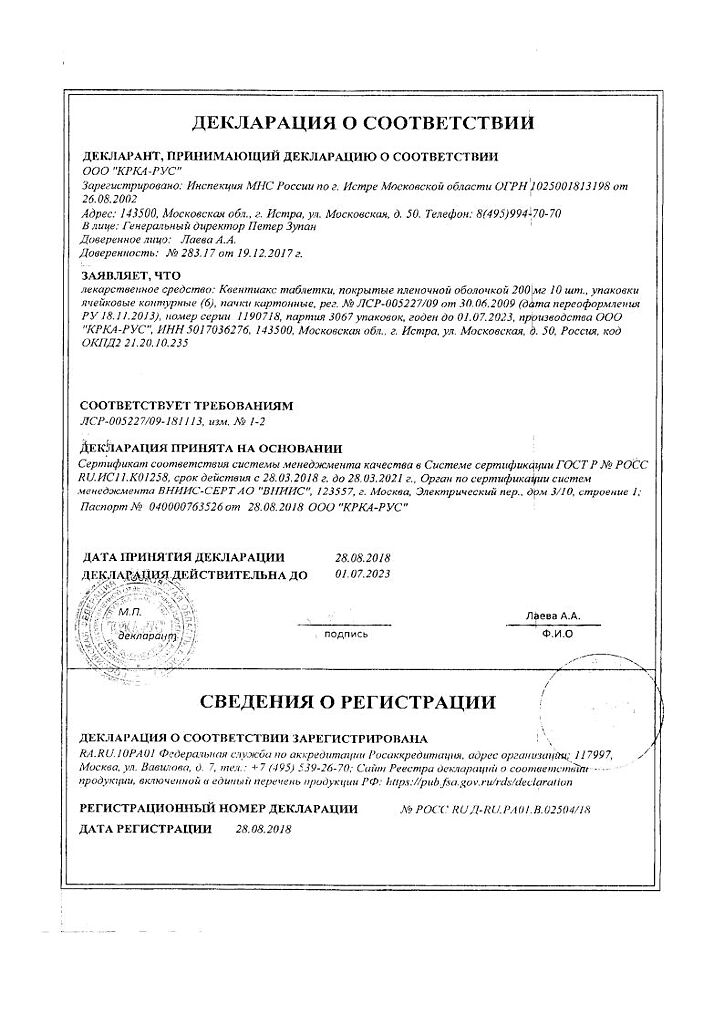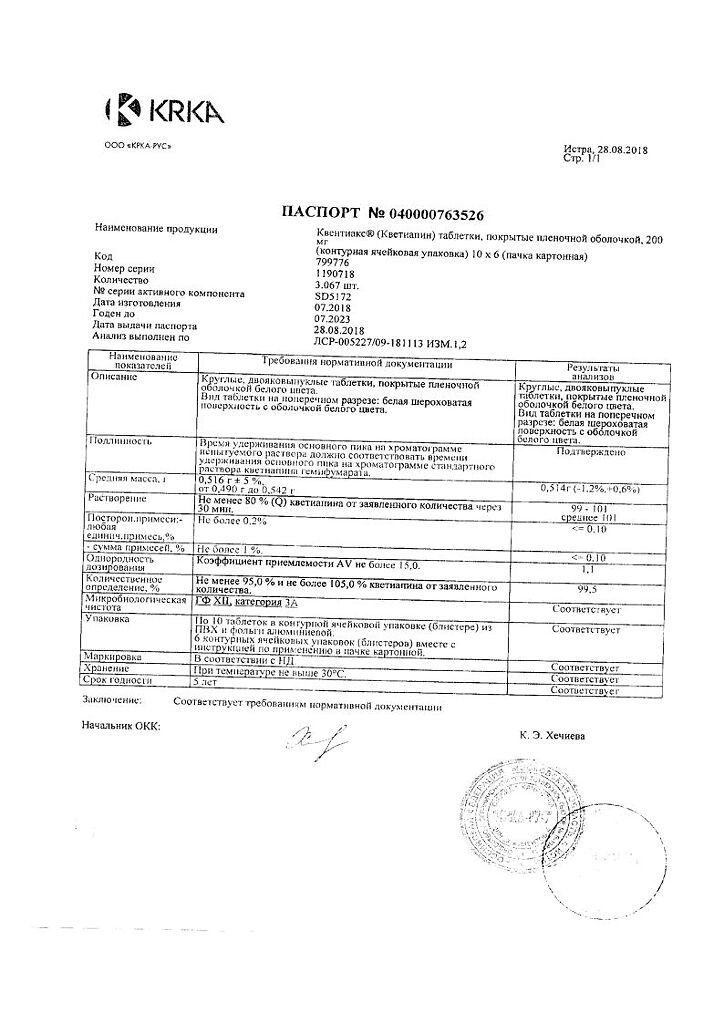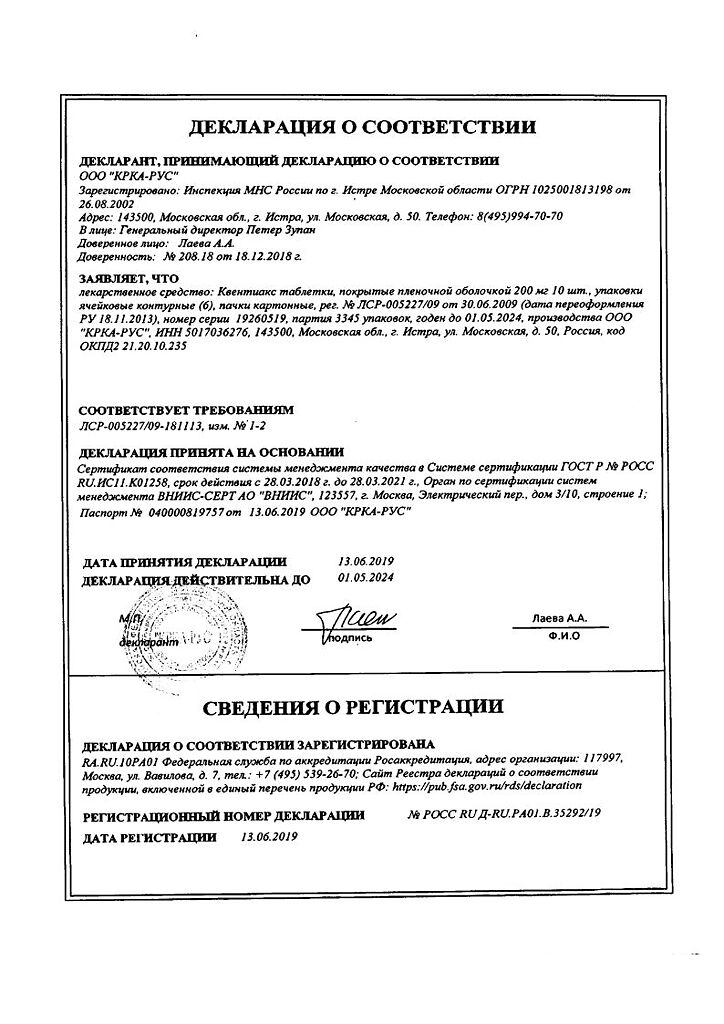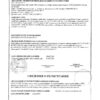No products in the cart.
Quentiax, 200 mg 60 pcs
€1.00
Out of stock
(E-mail when Stock is available)
Description
an antipsychotic (neuroleptic)
Indications
Indications
For the treatment of schizophrenia.
For the treatment of manic episodes in bipolar disorder.
For the treatment of depressive episodes of moderate to severe severity in the structure of bipolar disorder.
The drug is not indicated for the prevention of manic and depressive episodes.
Pharmacological effect
Pharmacological effect
antipsychotic (neuroleptic)
Special instructions
Special instructions
Use in patients with cardiovascular and cerebrovascular diseases or other conditions predisposing to arterial hypotension, use in elderly patients, liver failure, history of seizures, risk of stroke and aspiration pneumonia.
Although the effectiveness and safety of quetiapine in children and adolescents aged 10-17 years have been studied in clinical studies, the use of Quentiax® in patients under the age of 18 years is not indicated.
Elderly patients
Quentiax®, like other antipsychotics, should be used with caution in elderly patients, especially at the beginning of therapy. The dose should be titrated more slowly and the daily therapeutic dose should be lower than in younger patients, depending on clinical response and individual tolerability. The mean clearance of quetiapine was reduced by 30-50% in elderly patients compared to younger patients.
Efficacy and safety have not been studied in patients over 65 years of age with depressive episodes as part of bipolar disorder.
Patients with kidney failure
No dose adjustment is required.
Patients with liver failure
Quetiapine is extensively metabolized in the liver. Therefore, caution should be exercised when using Quentiax® in patients with liver failure, especially at the beginning of therapy. It is recommended to begin therapy with a dose of 25 mg/day and increase the dose daily by 25-50 mg until an effective dose is achieved.
Since Quentiax® has several indications for use, its safety profile is determined depending on the patient’s diagnosis and dose of the drug.
Children and adolescents (ages 10 to 17 years)
Quentiax® is not indicated for use in children and adolescents under 18 years of age due to insufficient data on use in this age group. According to the results of clinical studies, some adverse reactions (increased appetite, increased concentration of prolactin in the blood serum, vomiting, rhinitis and fainting) were observed in children and adolescents with a higher frequency than in adult patients, or had other clinical manifestations (EPS and irritability). An increase in blood pressure was also noted, which was not observed in adult patients. Changes in thyroid function have also been observed in children and adolescents.
The effects on growth, puberty, mental development and behavioral reactions with long-term use (more than 26 weeks) of quetiapine have not been studied.
In placebo-controlled studies in children and adolescents with schizophrenia and mania in bipolar disorder, the incidence of EPS was higher with quetiapine compared with placebo.
Suicide/suicidal ideation or clinical worsening
Depression in bipolar disorder is associated with an increased risk of suicidal ideation, self-harm, and suicide (suicide-related events). This risk persists until significant remission occurs. Because it may take several weeks or more for the patient’s condition to improve from the start of treatment, patients should be under close medical supervision until improvement occurs. According to generally accepted clinical experience, the risk of suicide may increase in the early stages of remission.
Patients (especially those at increased risk for suicide) and their caregivers should be warned to monitor for clinical worsening, suicidal behavior or thoughts, unusual changes in behavior, and to seek immediate medical attention if these occur.
In short-term, placebo-controlled clinical trials in depressed patients with bipolar disorder, the risk of suicide-related events was 3.0% (7/233) for quetiapine and 0% (0/120) for placebo in patients aged 18–24 years, 1.8% (19/1616) for quetiapine and 1.8% (11/622) for placebo in patients over 25 years of age. A population-based retrospective study of quetiapine in patients with major depressive disorder found an increased risk of self-harm and suicide attempts in patients aged 25 to 64 years without a history of self-harm taking quetiapine with other antidepressants.
Other psychiatric disorders treated with quetiapine are also associated with an increased risk of suicide-related events. In addition, such conditions may be comorbid with a depressive episode. Thus, the precautions used when treating patients with a depressive episode should also be taken when treating patients with other mental disorders.
If quetiapine therapy is abruptly discontinued, the potential risk of suicide-related events should be taken into account.
Patients with a history of suicidal events, as well as patients who clearly express suicidal thoughts before starting therapy, are at increased risk of suicidal intent and suicide attempts and should be carefully monitored during treatment. An FDA meta-analysis of placebo-controlled studies of antidepressants, summarizing data from approximately 4,400 children and adolescents and 7,700 adult patients with mental disorders, found an increased risk of suicidal behavior with antidepressants compared with placebo in children, adolescents and adult patients under 25 years of age. This meta-analysis does not include studies using quetiapine (see section “Pharmacodynamics”).
In short-term placebo-controlled studies across all indications and all age groups, the incidence of suicide events was 0.8% for both quetiapine (76/9327) and placebo (37/4845).
In these studies in patients with schizophrenia, the risk of suicide-related events was 1.4% (3/212) for quetiapine and 1.6% (1/62) for placebo in patients aged 18–24 years, 0.8% (13/1663) for quetiapine and 1.1% (5/463) for placebo in patients aged over 25 years, 1.4% (2/147) for quetiapine and 1.3% (1/75) for placebo in patients under 18 years of age.
In patients with manic bipolar disorder, the risk of suicide-related events was 0% (0/60) for quetiapine and 0% (0/58) for placebo in patients aged 18–24 years, 1.2% (6/496) for quetiapine and 1.2% (6/503) for placebo in patients over 25 years of age, 1.0% (2/193) for quetiapine and 0% (0/90) for placebo in patients under 18 years of age.
Metabolic disorders
Given the risk of deterioration in the metabolic profile, including changes in body weight, plasma glucose and lipid concentrations, observed during clinical studies, patients’ metabolic parameters should be assessed at the beginning of therapy and should be monitored regularly during therapy. If these indicators worsen, appropriate treatment should be undertaken.
Extrapyramidal symptoms
There was an increase in the incidence of EPS when taking quetiapine in adult patients with a major depressive episode in the structure of bipolar disorder or major depressive disorder compared to placebo (see section “Side effects”).
The use of quetiapine has been associated with the development of akathisia, which is characterized by subjectively unpleasant restlessness or anxiety, and is often accompanied by an inability to sit or stand still. Such phenomena are most often observed in the first few weeks of treatment. Increasing the dose in patients who develop such symptoms may have a negative effect.
Tardive dyskinesia
If symptoms of tardive dyskinesia develop, it is recommended to reduce the dose of the drug or gradually discontinue it. Symptoms of tardive dyskinesia may intensify or even occur after stopping the drug (see section “Side effects”).
Drowsiness and dizziness
During quetiapine therapy, drowsiness and associated symptoms, such as sedation, may occur (see section “Side effects”). In clinical studies involving patients with depression in the structure of bipolar disorder and with a depressive episode, somnolence usually developed during the first three days of therapy. The severity of this adverse reaction was generally minor or moderate. If severe drowsiness develops, patients with depression as part of bipolar disorder and patients with a depressive episode may require more frequent visits to the doctor within 2 weeks from the onset of drowsiness or until the severity of symptoms decreases. In some cases, discontinuation of quetiapine therapy may be necessary.
During quetiapine therapy, orthostatic hypotension and dizziness may occur (see section “Side effects”), usually during dose titration at the beginning of therapy. Patients, especially older patients, should be careful to avoid accidental injury (falls).
Patients with cardiovascular diseases
Caution should be exercised when using quetiapine in patients with cardiovascular, cerebrovascular disease and other conditions predisposing to arterial hypotension. In such patients, dose selection should be slower. Orthostatic hypotension may occur during quetiapine therapy, especially during dose titration at the beginning of therapy. If orthostatic hypotension occurs, a dose reduction or more gradual titration may be required.
Sleep apnea syndrome
Sleep apnea syndrome has been reported in patients taking quetiapine. In patients concomitantly taking CNS depressants or with a history of sleep apnea (eg, overweight/obese patients, male patients), quetiapine should be used with caution.
Seizures
There were no differences in the incidence of seizures in patients taking quetiapine or placebo. However, as with therapy with other antipsychotic drugs, caution is recommended when treating patients with a history of seizures (see section “Side effects”).
Neuroleptic malignant syndrome
While taking antipsychotic drugs, including quetiapine, neuroleptic malignant syndrome may develop (see section “Side effects”). Clinical manifestations of the syndrome include hyperthermia, altered mental status, muscle rigidity, lability of the autonomic nervous system, and increased creatine phosphokinase activity. In such cases, it is necessary to stop taking quetiapine and carry out appropriate treatment.
Severe neutropenia and agranulocytosis
In short-term, placebo-controlled clinical trials of quetiapine monotherapy, cases of severe neutropenia (neutrophil count <0.5 x 109/L) without infection were reported infrequently. The development of agranulocytosis (severe neutropenia associated with infections) has been reported in patients receiving quetiapine in clinical trials (rare), as well as during post-marketing use (including death). The majority of these cases of severe neutropenia occurred within 2 months of starting quetiapine therapy. No dose-dependent effect was found. Leukopenia and/or neutropenia resolved after discontinuation of quetiapine therapy. Possible risk factors for the occurrence of neutropenia are a previous low white blood cell count and a history of drug-induced neutropenia. The development of agranulocytosis was also noted in patients without risk factors. The possibility of neutropenia should be considered in patients with infection, especially in the absence of obvious predisposing factors, or in patients with unexplained fever, and these cases should be managed in accordance with clinical guidelines.
In patients with a neutrophil count <1.0 x 109/L, quetiapine should be discontinued. The patient should be observed for possible symptoms of infection and the neutrophil count should be monitored (until the count rises to 1.5 x 109/L).
Patients should be informed and promptly report any signs/symptoms of agranulocytosis or infection (eg, fever, weakness, lethargy, sore throat) throughout therapy with Quentiax.
Anticholinergic (muscarinic) effects
Norquetiapine, the active metabolite of quetiapine, exhibits moderate to high affinity for several muscarinic receptor subtypes, which explains the development of ADRs due to anticholinergic effects when quetiapine is used at recommended doses, during concomitant use of other anticholinergic drugs, and in overdose. Caution should be exercised when using quetiapine in patients taking cholinergic (muscarinic) receptor antagonists, as well as in patients with urinary retention, including a history of clinically significant prostatic hypertrophy, intestinal obstruction or related conditions, increased intraocular pressure or angle-closure glaucoma.
Interaction with other drugs
Also see the section “Interaction with other drugs”.
The simultaneous use of quetiapine with powerful inducers of microsomal liver enzymes, such as carbamazepine and phenytoin, helps to reduce the concentration of quetiapine in the blood plasma and may reduce the effectiveness of therapy with Quentiax®.
The use of Quentiax® in patients receiving inducers of microsomal liver enzymes is possible only if the expected benefit from drug therapy outweighs the risk associated with discontinuation of inducers of microsomal liver enzymes. Changing the dose of drugs that induce microsomal liver enzymes should be gradual. If necessary, they can be replaced with drugs that do not induce microsomal liver enzymes (for example, valproic acid drugs).
Body weight
An increase in body weight was observed while taking quetiapine. Clinical monitoring of patients is recommended in accordance with accepted standards of therapy (see section “Side Effects”).
Hyperglycemia
While taking quetiapine, it is possible to develop hyperglycemia and/or develop and exacerbate diabetes mellitus, sometimes accompanied by the development of ketoacidosis or coma, including death. In some cases, previous weight gain was noted, which may be a predisposing factor. Regular monitoring of body weight and symptoms of hyperglycemia, such as polydipsia, polyuria, polyphagia and weakness, is recommended in patients taking antipsychotics, including quetiapine. Clinical monitoring of patients with diabetes mellitus and patients with risk factors for developing diabetes mellitus is recommended (see section “Side Effects”).
Lipid concentration
While taking quetiapine, it is possible to increase the concentration of triglycerides, total cholesterol and LDL cholesterol, as well as a decrease in the concentration of HDL in the blood plasma (see section “Side Effects”). These changes should be adjusted in accordance with current recommendations.
QT prolongation
There was no relationship between taking quetiapine and a persistent increase in the absolute value of the QT interval. However, prolongation of the QT interval has been observed with the use of quetiapine in therapeutic doses and with an overdose of quetiapine (see section “Overdose”). Caution should be exercised when using quetiapine, as with other antipsychotic drugs, in patients with cardiovascular disease and a history of QT prolongation. Caution should also be exercised when using quetiapine simultaneously with drugs that prolong the QTc interval, other antipsychotics, especially in the elderly, in patients with congenital long QT syndrome, chronic heart failure, myocardial hypertrophy, hypokalemia or hypomagnesemia (see section “Interaction with other drugs”).
Cardiomyopathy and myocarditis
During clinical trials and post-registration use, cases of cardiomyopathy and myocarditis were observed, but a causal relationship with the drug has not been established. The appropriateness of quetiapine therapy should be assessed in patients with suspected cardiomyopathy or myocarditis.
Acute reactions associated with drug withdrawal
If quetiapine is abruptly discontinued, the following acute reactions (withdrawal syndrome) may occur: nausea, vomiting, insomnia, headache, dizziness and irritability. Therefore, it is recommended that Quentiax® be discontinued gradually over at least one or two weeks.
Elderly patients with dementia
Quentiax® is not indicated for the treatment of psychosis associated with dementia. Some atypical antipsychotics in randomized placebo-controlled trials increased the risk of cerebrovascular events in patients with dementia by approximately 3-fold. The mechanism for this increased risk has not been studied. A similar risk of increased incidence of cerebrovascular complications cannot be excluded for other antipsychotic drugs or other patient groups. Quentiax should be used with caution in patients at risk of stroke.
An analysis of the use of atypical antipsychotics for the treatment of psychosis associated with dementia in elderly patients revealed an increased mortality rate in the group of patients receiving drugs of this group compared with the placebo group. Two 10-week placebo-controlled studies of quetiapine in a similar group of patients (n=710, mean age: 83 years, age range: 56-99 years) showed that mortality in the quetiapine group was 5.5%, and 3.2% in the placebo group. The causes of death observed in these patients were consistent with those expected for this population. No causal relationship has been identified between quetiapine treatment and the risk of increased mortality in elderly patients with dementia.
Elderly patients with Parkinson’s disease/parkinsonism
A population-based retrospective study of quetiapine in patients with major depressive disorder found an increased risk of death in patients aged > 65 years. An increased risk was not detected when patients with Parkinson’s disease were excluded from the analysis. Caution should be exercised when prescribing quetiapine to elderly patients with Parkinson’s disease.
Dysphagia
Dysphagia (see section “Side effects”) and aspiration were observed during therapy with quetiapine. The cause-and-effect relationship between the occurrence of aspiration pneumonia and the use of quetiapine has not been established. However, caution should be exercised when using Quentiax® in patients at risk of aspiration pneumonia.
Constipation and intestinal obstruction
Constipation is a risk factor for intestinal obstruction. During the use of quetiapine, the development of constipation and intestinal obstruction was noted (see section “Side effects”), including cases with a fatal outcome in patients at high risk of intestinal obstruction, including those receiving multiple concomitant medications that reduce intestinal motility, even in the absence of complaints of constipation. Patients with intestinal obstruction/ileus require urgent measures and close monitoring.
Venous thromboembolism
Cases of venous thromboembolism have been reported while taking antipsychotics. Before and during therapy with antipsychotic drugs, including quetiapine, risk factors should be assessed and preventive measures taken.
Pancreatitis
During clinical trials and post-registration use, cases of pancreatitis were observed, but a causal relationship with the drug has not been established. Post-marketing reports indicate that many patients had risk factors for pancreatitis, such as elevated triglyceride concentrations (see Lipid Concentrations), cholelithiasis, and alcohol consumption.
Liver disorders
If jaundice develops, quetiapine should be discontinued.
Additional information
Data on the concomitant use of quetiapine with divalproate or lithium during acute moderate or severe manic episodes are limited. This combination therapy was well tolerated and had an additive effect at 3 weeks of treatment.
Misuse and Abuse
Cases of misuse and abuse have been reported. Caution should be exercised when prescribing quetiapine to patients with a history of alcohol or drug abuse.
Special information on excipients
The drug Quentiax® contains lactose, so it should not be used for the following conditions: lactose intolerance, lactase deficiency, glucose-galactose malabsorption syndrome.
The drug Quentiax® may cause drowsiness, therefore, during the treatment period, patients are not recommended to work with mechanisms that require increased concentration, including driving vehicles.
Active ingredient
Active ingredient
Quetiapine
Composition
Composition
1 film-coated tablet, 25 mg contains:
Core
Active ingredient:
Quetiapine fumarate (quetiapine hemifumarate) 28.78 mg (equivalent to quetiapine 25 mg)
Excipients: lactose monohydrate, calcium hydrogen phosphate dihydrate, microcrystalline cellulose type 101, microcrystalline cellulose type 102, povidone K-25, sodium carboxymethyl starch (type A), magnesium stearate
Film casing
Hypromellose, titanium dioxide (E171), macrogol-4000, yellow iron oxide dye (E172), red iron oxide dye (E172)
1 film-coated tablet, 100 mg contains:
Core
Active ingredient:
Quetiapine fumarate (quetiapine hemifumarate) 115.13 mg (equivalent to quetiapine 100 mg)
Excipients: lactose monohydrate, calcium hydrogen phosphate dihydrate, microcrystalline cellulose type 101, microcrystalline cellulose type 102, povidone K-25, sodium carboxymethyl starch (type A), magnesium stearate
Film casing
Hypromellose, titanium dioxide (E171), macrogol-4000, yellow iron oxide dye (E172)
1 film-coated tablet, 200 mg/300 mg contains:
Core
Active ingredient:
Quetiapine fumarate (quetiapine hemifumarate) 230.26 mg (equivalent to quetiapine 200 mg)/Quetiapine fumarate (quetiapine hemifumarate) 345.39 mg (equivalent to quetiapine 300 mg)
Excipients: lactose monohydrate, calcium hydrogen phosphate dihydrate, microcrystalline cellulose type 101, microcrystalline cellulose type 102, povidone K-25, sodium carboxymethyl starch (type A), magnesium stearate
Film casing
Hypromellose, titanium dioxide (E171), macrogol-4000
Pregnancy
Pregnancy
Pregnancy
Published data on use during pregnancy (300-1000 pregnancy outcomes), including anecdotal reports and observational studies, have not shown an increased risk of malformations with treatment. However, no definite conclusion can be drawn from the available data. Animal studies have shown reproductive toxicity. As a result, quetiapine should only be used during pregnancy if the expected benefit to the mother justifies the potential risk to the fetus.
When using antipsychotic drugs, including quetiapine, in the third trimester of pregnancy, newborns are at risk of developing adverse reactions of varying severity and duration, including EPS and/or withdrawal syndrome. Agitation, hypertension, hypotension, tremor, somnolence, respiratory distress, or feeding disturbances have been reported. In this regard, the condition of newborns should be carefully monitored.
Breastfeeding period
Reports of the excretion of quetiapine into breast milk have been published, but the extent of excretion has not been established. Due to the lack of reliable data, it is necessary to decide whether to stop breastfeeding or discontinue Quentiax®.
Contraindications
Contraindications
Hypersensitivity to any of the components of the drug.
Lactose intolerance, lactase deficiency, glucose-galactose malabsorption syndrome.
Concomitant use with cytochrome P450 inhibitors, such as azole antifungals, erythromycin, clarithromycin and nefazodone, as well as protease inhibitors (see section “Interaction with other drugs”).
Breastfeeding period.
Although the effectiveness and safety of quetiapine in children and adolescents aged 10-17 years have been studied in clinical studies, the use of Quentiax® in patients under the age of 18 years is not indicated.
Interaction
Interaction
Caution should be exercised when using Quentiax® simultaneously with other drugs that affect the central nervous system, as well as with alcohol.
Caution should be exercised in patients taking other cholinergic (muscarinic) receptor antagonists.
The cytochrome P450 isoenzyme 3A4 is the main isoenzyme responsible for the metabolism of quetiapine, which occurs through the cytochrome P450 system. In healthy volunteers, simultaneous use of quetiapine (at a dose of 25 mg) with ketoconazole, an inhibitor of the CYP3A4 isoenzyme, led to an increase in the area under the concentration-time curve (AUC) of quetiapine by 5-8 times.
Therefore, the simultaneous use of quetiapine and inhibitors of the CYP3A4 isoenzyme is contraindicated. During quetiapine therapy, it is not recommended to drink grapefruit juice.
In a pharmacokinetic study, the use of quetiapine at various dosages before or concomitantly with carbamazepine led to a significant increase in quetiapine clearance and, accordingly, a decrease in AUC by an average of 13%, compared to taking quetiapine without carbamazepine. In some patients, the decrease in AUC was even more pronounced. This interaction is accompanied by a decrease in quetiapine plasma concentrations and may reduce the effectiveness of quetiapine therapy. Concomitant use of quetiapine with phenytoin, another inducer of microsomal liver enzymes, was accompanied by an even more pronounced (approximately 450%) increase in quetiapine clearance. The use of quetiapine in patients receiving microsomal liver enzyme inducers is possible only if the expected benefit from quetiapine therapy outweighs the risk associated with discontinuation of the microsomal liver enzyme inducer drug. Changing the dose of drugs that induce microsomal liver enzymes should be gradual. If necessary, they can be replaced with drugs that do not induce microsomal liver enzymes (for example, valproic acid drugs).
The pharmacokinetics of quetiapine did not change significantly with simultaneous use of the antidepressant imipramine (inhibitor of the CYP2D6 isoenzyme) or fluoxetine (inhibitor of the CYP3A4 and CYP2D6 isoenzymes).
The pharmacokinetics of quetiapine does not change significantly when used concomitantly with the antipsychotic drugs risperidone or haloperidol. However, concomitant administration of quetiapine and thioridazine resulted in an approximately 70% increase in quetiapine clearance.
The pharmacokinetics of quetiapine does not change significantly with simultaneous use of cimetidine.
The pharmacokinetics of lithium preparations does not change with simultaneous use of quetiapine.
When quetiapine was coadministered with lithium in adult patients with an acute manic episode, there was a higher incidence of EPS-related adverse reactions (especially tremor), somnolence, and weight gain compared with patients taking quetiapine with placebo in a 6-week randomized trial.
There were no clinically significant changes in the pharmacokinetics of valproic acid and quetiapine with simultaneous use of semisodium valproate and quetiapine.
A retrospective study of children and adolescents who received sodium valproate and quetiapine alone or both drugs simultaneously found a higher incidence of leukopenia and neutropenia in the combination therapy group compared with the monotherapy group.
Pharmacokinetic studies examining the interaction of Quentiax® with drugs used for cardiovascular diseases have not been conducted.
Caution should be exercised when quetiapine is used concomitantly with drugs that can cause electrolyte imbalance and prolongation of the QTc interval.
False-positive results of screening tests for methadone and tricyclic antidepressants using enzyme-linked immunosorbent assays have been reported in patients taking quetiapine. To confirm the screening results, a chromatographic study is recommended.
With a single dose of 2 mg of lorazepam while taking quetiapine at a dose of 250 mg 2 times a day, the clearance of lorazepam is reduced by approximately 20%.
Quetiapine did not induce liver microsomal enzymes involved in the metabolism of phenazone.
Overdose
Overdose
Symptoms
Symptoms noted in overdose were mainly due to an increase in the known pharmacological effects of quetiapine, such as drowsiness and sedation, tachycardia, decreased blood pressure and anticholinergic effects.
Overdose may result in QT prolongation, seizures, status epilepticus, rhabdomyolysis, respiratory depression, urinary retention, confusion, delirium and/or agitation, coma and death.
In patients with a history of severe cardiovascular disease, the risk of side effects from overdose may increase (see section “Special Instructions”).
Treatment
There are no specific antidotes to quetiapine. In cases of severe intoxication, one should be aware of the possibility of overdose with several drugs. It is recommended to take measures aimed at maintaining respiratory and cardiovascular function, ensuring adequate oxygenation and ventilation. There have been reports of resolution of severe central nervous system (CNS) adverse effects, including coma and delirium, following intravenous administration of physostigmine (1-2 mg) under continuous electrocardiogram (ECG) monitoring. This treatment is not recommended as standard treatment due to the potential negative effects of physostigmine on cardiac conduction. The use of physostigmine is possible only if there are no abnormalities in ECG readings. Physostigmine should not be used if there is cardiac arrhythmia, blockade of any degree, or if the QRS complex is widened.
In the event of refractory hypotension following an overdose of quetiapine, treatment should be carried out with intravenous fluids and/or sympathomimetic drugs (epinephrine and dopamine should not be prescribed, since stimulation of β-adrenergic receptors may cause an increase in the decrease in blood pressure against the background of blockade of α-adrenergic receptors with quetiapine).
Gastric lavage (after intubation if the patient is unconscious) and the use of activated charcoal and laxatives may help eliminate unabsorbed quetiapine, but the effectiveness of these measures has not been studied.
Close medical observation should continue until the patient’s condition improves.
Clinical pharmacology
Clinical pharmacology
Pharmacodynamics
Mechanism of action
Quetiapine is an atypical antipsychotic drug. Quetiapine and its active metabolite N-desalkylquetiapine (norquetiapine) interact with a wide range of neurotransmitter receptors in the brain. Quetiapine and N-desalkylquetiapine exhibit high affinity for 5HT2-serotonin receptors and
D1-, D2-dopamine receptors of the brain. Antagonism to these receptors, combined with higher selectivity for 5HT2-serotonin receptors than for D2-dopamine receptors, determines the main clinical antipsychotic properties of quetiapine and the low incidence of extrapyramidal adverse reactions. Quetiapine and norquetiapine do not show significant affinity for benzodiazepine receptors, but have high affinity for histamine and α1-adrenergic receptors and moderate affinity for α2-adrenergic receptors. In addition, quetiapine has no or low affinity for muscarinic receptors, while norquetiapine exhibits moderate to high affinity for several muscarinic receptor subtypes, which explains the drug’s anticholinergic (muscarinic) effects. Inhibition of the norepinephrine transporter and partial agonism of 5HT1A-serotonin receptors, exhibited by N-dealkylquetiapine, may determine the antidepressant effect of the drug.
Pharmacodynamic effects
Quetiapine is active in tests of antipsychotic activity such as conditioned avoidance. It also blocks the effects of dopamine agonists, assessed either in behavioral or electrophysiological studies, and increases concentrations of the dopamine metabolite, a neurochemical indicator of D2 receptor blockade. Results from studies of extrapyramidal symptoms (EPS) in preclinical studies have shown that quetiapine differs from standard antipsychotics and has an atypical profile. Quetiapine does not cause increased sensitivity of dopamine D2 receptors with long-term use. Quetiapine causes mild catalepsy at doses that effectively block D2 receptors. Quetiapine selectively acts on the limbic system, causing a depolarizing blockade of mesolimbic, but not nigrostriatal dopaminergic neurons. When administered short- or long-term, quetiapine had minimal potential to cause dystonia in haloperidol-sensitized or unmedicated capuchin monkeys.
Clinical effectiveness
Quetiapine is effective against both positive and negative symptoms of schizophrenia.
Quetiapine is effective as monotherapy for moderate to severe manic episodes. There are no data on long-term use of quetiapine for the prevention of subsequent manic and depressive episodes. Data on the use of quetiapine in combination with semisodium valproate or lithium for moderate to severe manic episodes are limited, but this combination therapy was generally well tolerated. In addition, quetiapine at doses of 300 mg and 600 mg is effective in patients with moderate to severe bipolar disorder I and II. At the same time, the effectiveness of quetiapine when taken at a dose of 300 mg and 600 mg per day is comparable. Quetiapine is effective in patients with schizophrenia and mania when taken twice daily, although the half-life of quetiapine is approximately 7 hours. The effect of quetiapine on 5HT2- and D2-receptors lasts up to 12 hours after taking the drug.
When taking quetiapine with dose titration in schizophrenia, the frequency of EPS and concomitant use of m-anticholinergics was comparable to that when taking placebo. When quetiapine was prescribed in fixed doses from 75 to 750 mg/day to patients with schizophrenia, the incidence of EPS and the need for concomitant use of m-anticholinergics did not increase.
When quetiapine was used in doses up to 800 mg/day for the treatment of moderate to severe manic episodes, either as monotherapy or in combination with lithium or semisodium valproate, the incidence of EPS and concomitant use of m-anticholinergic drugs was comparable to that with placebo.
Pharmacokinetics
Suction
Quetiapine is well absorbed from the gastrointestinal tract. Food intake does not significantly affect bioavailability. The equilibrium molar concentration of the active metabolite N-desalkylquetiapine is 35% of that of quetiapine.
The pharmacokinetics of quetiapine is linear.
Distribution
Approximately 83% of quetiapine is bound to plasma proteins.
Metabolism
In vitro studies have shown that the CYP3A4 isoenzyme is a key isoenzyme in the metabolism of quetiapine, mediated by the cytochrome P450 system. N-desalkylquetiapine is formed and eliminated with the participation of the CYP3A4 isoenzyme.
Quetiapine and some of its metabolites (including N-desalkylquetiapine) have weak inhibitory activity against cytochrome P450 isoenzymes 1A2, 2C9, 2C19, 2D6 and 3A4, but only at concentrations 5-50 times higher than those observed at the commonly used effective dose of 300-800 mg/day. Based on the results of in vitro studies, it should not be expected that the simultaneous use of quetiapine with other drugs will lead to clinically significant inhibition of the metabolism of other drugs mediated by the cytochrome P450 system.
Withdrawal
The half-life of quetiapine and N-desalkylquetiapine is approximately 7 and 12 hours, respectively.
Approximately 73% of quetiapine is excreted by the kidneys and 21% through the intestines. Quetiapine is actively metabolized in the liver, less than 5% of quetiapine is not metabolized and is excreted unchanged by the kidneys or through the intestines.
Pharmacokinetics in different patient groups
Gender
There are no differences in pharmacokinetic parameters between men and women.
Elderly patients
The average clearance of quetiapine in elderly patients is 30-50% less than in patients aged 18 to 65 years.
Impaired kidney function
The average plasma clearance of quetiapine is reduced by approximately 25% in patients with severe renal impairment (creatinine clearance less than 30 ml/min/1.73 m2), but individual clearance rates are within the range of values found in healthy volunteers.
Liver dysfunction
In patients with liver failure (compensated alcoholic cirrhosis), the average plasma clearance of quetiapine is reduced by approximately 25%. Since quetiapine is extensively metabolized in the liver, in patients with liver failure, the plasma concentration of quetiapine may increase, which requires dose adjustment.
Storage conditions
Storage conditions
During production at KRKA-RUS LLC, Russia:
At a temperature not exceeding 25 ºС, in the original packaging (blister packaging).
During production at JSC KRKA, d.d., Novo Mesto, Slovenia:
At a temperature not exceeding 25 ºС, in the original packaging (blister).
Keep out of the reach of children.
Shelf life
Shelf life
5 years.
Do not use the drug after the expiration date.
Manufacturer
Manufacturer
KRKA-RUS, Russia
Additional information
| Shelf life | 5 years. Do not use the drug after the expiration date. |
|---|---|
| Conditions of storage | When manufacturing at KRKA-RUS, Russia: At the temperature not more than 25 ºС, in the original package (outline cell packing). When produced at KRKA, d.d., Novo mesto, Slovenia: At a temperature not higher than 25 ºC, in the original package (blister). Keep out of reach of children. |
| Manufacturer | KRKA dd Novo mesto, Slovenia |
| Medication form | pills |
| Brand | KRKA dd Novo mesto |
Related products
Buy Quentiax, 200 mg 60 pcs with delivery to USA, UK, Europe and over 120 other countries.

